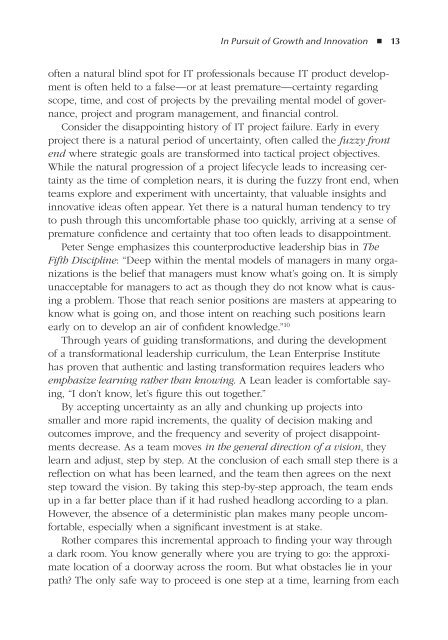Run-Grow-Transform-Chapter-One-distribute-freely
Run-Grow-Transform-Chapter-One-distribute-freely
Run-Grow-Transform-Chapter-One-distribute-freely
You also want an ePaper? Increase the reach of your titles
YUMPU automatically turns print PDFs into web optimized ePapers that Google loves.
In Pursuit of <strong>Grow</strong>th and Innovation ◾ 13<br />
often a natural blind spot for IT professionals because IT product development<br />
is often held to a false—or at least premature—certainty regarding<br />
scope, time, and cost of projects by the prevailing mental model of governance,<br />
project and program management, and financial control.<br />
Consider the disappointing history of IT project failure. Early in every<br />
project there is a natural period of uncertainty, often called the fuzzy front<br />
end where strategic goals are transformed into tactical project objectives.<br />
While the natural progression of a project lifecycle leads to increasing certainty<br />
as the time of completion nears, it is during the fuzzy front end, when<br />
teams explore and experiment with uncertainty, that valuable insights and<br />
innovative ideas often appear. Yet there is a natural human tendency to try<br />
to push through this uncomfortable phase too quickly, arriving at a sense of<br />
premature confidence and certainty that too often leads to disappointment.<br />
Peter Senge emphasizes this counterproductive leadership bias in The<br />
Fifth Discipline: “Deep within the mental models of managers in many organizations<br />
is the belief that managers must know what’s going on. It is simply<br />
unacceptable for managers to act as though they do not know what is causing<br />
a problem. Those that reach senior positions are masters at appearing to<br />
know what is going on, and those intent on reaching such positions learn<br />
early on to develop an air of confident knowledge.” 10<br />
Through years of guiding transformations, and during the development<br />
of a transformational leadership curriculum, the Lean Enterprise Institute<br />
has proven that authentic and lasting transformation requires leaders who<br />
emphasize learning rather than knowing. A Lean leader is comfortable saying,<br />
“I don’t know, let’s figure this out together.”<br />
By accepting uncertainty as an ally and chunking up projects into<br />
smaller and more rapid increments, the quality of decision making and<br />
outcomes improve, and the frequency and severity of project disappointments<br />
decrease. As a team moves in the general direction of a vision, they<br />
learn and adjust, step by step. At the conclusion of each small step there is a<br />
reflection on what has been learned, and the team then agrees on the next<br />
step toward the vision. By taking this step-by-step approach, the team ends<br />
up in a far better place than if it had rushed headlong according to a plan.<br />
However, the absence of a deterministic plan makes many people uncomfortable,<br />
especially when a significant investment is at stake.<br />
Rother compares this incremental approach to finding your way through<br />
a dark room. You know generally where you are trying to go: the approximate<br />
location of a doorway across the room. But what obstacles lie in your<br />
path? The only safe way to proceed is one step at a time, learning from each<br />
TAF-K14527-12-0302-C001.indd 13<br />
13/08/12 8:25 PM


